
MAY CONTAIN NUTS

Search Shorpy
SHORPY ART

Framed or unframed, desk size to sofa size, printed by us in Arizona and Alabama since 2007. Explore now.
Join and Share
Ad-Free Shorpy
Shorpy is funded by you. Patreon contributors get an ad-free experience.
Learn more.

Recent comments
- Heckuva remote control!
- Sometimes — Things Go Bump!
- I SEE THE LIGHT
- Union Switch and Signal Company
- Get That Light Out Of My Eyes
- Eggs. Eggs. Eggs. The Egg Man is Here!
- Foreboding caption
- Famous Hollywood faces
- Not just S&P
- re: Those things in the jar
- Up In Smoke
- Medical Smoking
- Quick fix
- A Quink Comment
- If You’re Like Me, Never
- Delivering the News
- U.S.A.
- S&P
- 1940 Zenith radio model 6G601
- Quality goes in before the name goes on!
- Snazzy skirt
- Carbon Arc Lamps
- Illuminate us
- I remember it well
- I can't prove it
- Complicated then, forgotten now
- Bryan-Stevenson
- Skinny is as skinny does
- How do you rest in peace
- Riding the footboards
Member Photos
The Shorpy
Print Emporium
Print Emporium
Search Shorpy
Search results -- 30 results per page
- Washington Monuments: 1922
- May 5, 1922. Washington, D.C. "Vista of Monument from Lincoln Memorial." National ... shortly before the dedication of the Memorial on May 30, 1922. Robert Lincoln (79) was there.
The Reflecting Pool is not yet in ... Posted by Dave - 07/17/2012 - 10:34pm -
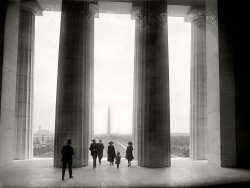
- Isham Jones Orchestra: 1922
- New York circa 1922. "Isham Jones Orchestra." Playing May 7 at Grace Methodist Episcopal . ... cut a few discs, and return. On its NYC trip in early May, 1922, it cut three records:
"Sun God" b/w "High Brown Blues" (Brunswick ... Posted by Dave - 08/01/2012 - 5:37pm -
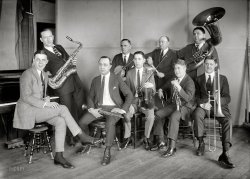
- Candy Girls: 1922
- Washington, D.C., circa 1922. "Benj. Franklin candy store, 13th Street N.W., interior." National Photo ... at this picture?
While You Were Away
1922 Advertisement
"Benj." Franklin Candies
Pays Us a Visit and ... Posted by Dave - 09/13/2011 - 9:49pm -
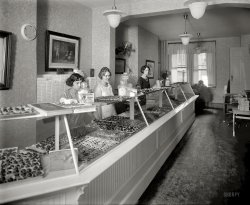
- Hanging Out: 1922
- July 1922. Washington, D.C. "Kallipolis Grotto, Potomac bathing beach." The Grotto ... contests.
Washington Post, July 11, 1922.
Grotto Day at Basin.
Band Concert and Sports Will ... Posted by Dave - 08/05/2012 - 5:03pm -
![Hanging Out: 1922 July 1922. Washington, D.C. "Kallipolis Grotto, Potomac bathing beach." The Grotto being one of Washington's many Masonic lodges. A big cigar, a bottle of pop, and Thou. National Photo Company glass negative. View full size.
CodpieceThe man seems to be wearing a weird garment! I wonder what the young ladies think?
DenizenBy-the-Jesus, that fellow's a Mainer if I ever saw one! (Effete Maine, down around Portland, has citizens; the rest of the state has denizens.)
Sore SpotsI'd like to think that the sores and his legs and the sores on her arms are coincidental.
[They're not just coincidental, they're nonexistent! Except on the negative. Note how the "sores" are also seen on clothing and even in the sand. - tterrace]
What's that smell?Nothing like hanging out next to the sewer clean out.
Re Codpiece, Shriner-styleOur dapper chaperon with the stogie waiting, the hat set just so, and the bottle of Moxie is sporting a oddly-torn Kallipolis Grotto shirt. Whatever these three are thinking, it probably is not "If we live another 90 years, we won't even be on Facebook." But they'd be wrong:
http://www.facebook.com/pages/Kallipolis-Grotto/190273837666381
The Maine ThingIf he's from Maine, he should be drinking a Moxie, but I don't recognize the beverage in his hand. Any sharp-eyed pop bottle spotters care to weigh in on what he's been imbibing?
Grotto DayFeatured activities included leap frog races, relay races, three-legged races and needle-threading contests.
Washington Post, July 11, 1922.
Grotto Day at Basin.
Band Concert and Sports Will
Feature Outing Tomorrow.
With a concert by the Kallipolis Grotto band, sports for children and grown-ups, a general picnic lunch and other stunts for members of the Grotto and their families, Grotto day will be observed tomorrow at the Tidal basin bathing beach.
M.W. Pickering, monarch of the Kallipolis Grotto; Edward Libey, secretary, and Charles Shackelford, master of ceremonies, are in charge of "Grotto day" at the bathing beach tomorrow.
The GrottoI'm a member of that Grotto.
(The Gallery, D.C., Swimming)](https://www.shorpy.com/files/images/SHORPY_06677u.thumbnail.jpg)
- Delicious and Refreshing: 1922
- February 13, 1922. Washington, D.C. "Unidentified woman." Demonstrating an ingenious ... bunch-up on the tendon over the back of her shoes. And in 1922 the appearance of a woman's stockings in public was still a very new ... Posted by Dave - 09/13/2011 - 12:07pm -
![Delicious and Refreshing: 1922 February 13, 1922. Washington, D.C. "Unidentified woman." Demonstrating an ingenious Prohibition-era fashion accessory, the cane-flask. View full size.
HmmmThree's a crowd? Love those great ice cream chairs.
On second thoughtI just sent a comment about the introduction of nylon stockings. Please delete the word "attractive" as in "attractive young women from the past." It really has no relevance to my comment.
I know, I know!!My vote would be for rum in the cane! Nothing goes better with Coke!
Hoisery Then and NowEvery time I see attractive young women from the past, I am sympathetic for their having to endure the unflattering stockings available then. It reinforces my understanding of the excitement that accompanied the introduction of nylon stockings.
I'll bet..it's not Coca-Cola in her cane.
I like the stockings...... but the shoes are a little matronly for my taste.
Pour DeuxI hope she has enough for two in that cane!
Silk StockingsMaybe unattractive now, but these expensive sheer silk stockings were the bee's knees when she wore them, and were an infinite improvement over the thick and saggy cotton and/or wool stockings that were more common. These don't wrinkle or droop on the calves, or bunch-up on the tendon over the back of her shoes. And in 1922 the appearance of a woman's stockings in public was still a very new topic. How they looked was still less of an issue than the fact that you could see them at all.
Never mind the stockings ...What's up with those "sensible" shoes?
I dig the shoesI think the shoes look kinda sexy, a cute feminine vamp on men's oxfords. My late grandmothers, born circa 1900, could tell us how these looked to contemporary eyes.
As Cole Porter saidIn olden days a glimpse of stocking
Was looked on as something shocking,
But now, God knows,
Anything Goes.
The shoes may be matronlybut I would bet her feet didn't hurt at the end of the day!
Sensible shoesWith tequila shooters in the heels, no doubt.
I wantthat hat!!!!
Waxing PoeticShe's darned cute,
And she has her own flask.
If you want a toot,
You just have to ask.
Don't forget to limpOf course, a sudden increase in the number of healthy young women with canes wouldn't arouse any suspicion whatsoever.
Say...That bird's got moxie.
Cane CapacityInquiring minds want know and some want to drink. The patent description didn't say how much it hooch it held.
New hero of the day:James E. Hale, inventor of the cane flask.
I admire the entrepreneurial spirit (pun intended) behind the man who actually patented the cane flask in 1888. Among the claimed improvements: "The above construction forms a convenient arrangement for carrying liquids, and its portability affords great convenience to travelers."
18th and ColumbiaOn the menu it says "(illegible) FOUNTAIN". There's still a Little Fountain Cafe at 2339 18th Street, which is well within the vicinity of the other photos in this series, and remains "undeveloped." And this place is selling Welch's grape juice, same as the People's Drug Store #10.
[The menu says OHIO FOUNTAIN - Dave]
Quel ChicLooks like she set her cute little purse on the table next to her. That coat is just stunning!
I still likethe term "tipple stick" best.
(The Gallery, D.C., Eateries & Bars, Natl Photo)](https://www.shorpy.com/files/images/05760u.thumbnail.jpg)
- Scooter Sk8rs: 1922
- September 15, 1922. Washington, D.C. "Scooter skates." On the right: Clarence Sherrill. ... Posted by Dave - 07/24/2012 - 7:16pm -
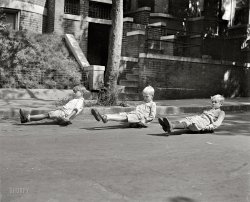
- Polar Volleyball: 1922
- February 1922. Washington, D.C. "Barefoot volleyball in snow." Recreation at Fort ... Costumes
Washington Post, February 3, 1922.
Snow and slush mean nothing to the army officers at Bolling field. ... the enlisted men are playing. To answer a question, in 1922 there were no prisoners of war held in the USA.
(The Gallery, D.C., ... Posted by Dave - 02/26/2014 - 8:59pm -
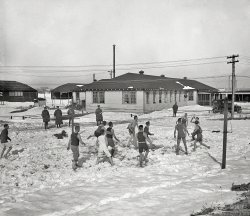
- My New Olds: 1922
- 1922. "Milan and Oldsmobile." Washington Nationals manager Clyde Milan. ... View full size.
Washington's Team? In 1922, the Washington franchise was nicknamed the "Senators." That franchise ... the team that was moved from Montreal (Expos).
[In 1922 the team was most commonly called the Nationals. - Dave]
... Posted by Dave - 07/23/2012 - 6:43pm -
![My New Olds: 1922 1922. "Milan and Oldsmobile." Washington Nationals manager Clyde Milan. National Photo Company Collection glass negative. View full size.
Washington's Team?In 1922, the Washington franchise was nicknamed the "Senators." That franchise moved to Minnesota (Twins) in 1962 and a NEW franchise was awarded to Washington (again nicknamed the "Senators") that same year. The nickname "Nationals" was given to the team that was moved from Montreal (Expos).
[In 1922 the team was most commonly called the Nationals. - Dave]
Nationals and SenatorsAccording to Wikipedia the name change happened in 1922. Unlike today's Nationals, the old team was in the American League. They gifted Milan with the new Olds, I guess, at the beginning of the season. He was the player-manager. They ended with a poor record 69 wins and 85 losses. Ironically, the NY Mets manager, Willie Randolph, was fired today for the same thing. The D.C. team at least waited till the end of the season. Milan never managed in the majors again.
(The Gallery, Cars, Trucks, Buses, Natl Photo, Sports)](https://www.shorpy.com/files/images/06276u.thumbnail.jpg)
- Tipping Point: 1922
- November 1922. Washington, D.C. "Auto wreck." Who'll be first to pinpoint the ... concrete frame buildings.
The photo date of November 1922 provided by Shorpy narrows it further. Gore had 3 permits issued prior to November 1922 for a reinforced concrete apartment building: 1925 16th Street NW (permit ... Posted by Dave - 03/05/2014 - 9:41am -
![Tipping Point: 1922 November 1922. Washington, D.C. "Auto wreck." Who'll be first to pinpoint the intersection? National Photo Company glass negative. View full size.
S It IsI have access to a database of DC building permits. All signs point to 1631 S Street NW. The photo of the reinforced concrete frame is showing the side elevation on 17th Street.
Fred H. Gore is listed as builder on 36 building permits between 1921 and 1937. Many of those are small one and two story buildings, only a few are for high rise concrete frame buildings.
The photo date of November 1922 provided by Shorpy narrows it further. Gore had 3 permits issued prior to November 1922 for a reinforced concrete apartment building: 1925 16th Street NW (permit issued 2/23/22), 1614 17th Street NW (7/1/22), and 1631 S Street NW (8/30/22). All would have been issued with enough time to complete the amount of construction shown in the photo.
1925 16th can be eliminated because it's a midblock building but the photo was taken from the yard of a corner building, which isn't possible for a midblock building like 1925 16th St.
1614 17th Street NW can be eliminated because, although it's near a corner, it's between 2 Victorian buildings that would have appeared in the photo.
1631 S Street NW wins by process of elimination. It's across from a rowhouse at the southwest corner of 17th and S streets. In the photo, the land to the left (north) is vacant and the building to the north of 1631 S Street is an art deco apartment built in 1940, so that matches.
If you look closely at the ground floor of the concrete frame on the right, you can see that they've begun to lay up the veneer brick and set in the stone window frame for a double window with a mullion between. This detail matches the window style of 1631 S Street NW. But then again, it also matches the detailing on 1614 17th St; both buildings are the same style and within 3 blocks of each other on 17th.
The ShelburneThe Shelburne apartments are at the northeast corner of 17th and Q S Streets NW. Completed in 1923.
[1631 S Street. Also known, over the years, as the Shelbourne. - Dave]
Oops, yes my bad: S street. For years, 17th and Q was where we went drinking.
View Larger Map
Camera vs. tipped carI count 15 people staring directly at the camera, including the five kids in the front row of the pack in the lower left. In the competition for the crowd’s attention, the camera pulls away a goodly number from the chief attraction: the tipped car in the road. These people have no idea that in 92 years, most members of the crowd would be holding up palm-sized rectangles, photographing each other, themselves, the car, then magically sending these images off into the ethereal data warehouse of words and pictures to be shared by millions of strangers.
14th and G StAcross the way the address appears as 1410 G Street.
[That's contractor Fred Gore's business address. Next guess? - Dave]
Fred H. GoreOn page 28 of the June 24, 1922 issue of American Contractor, under "Big Project Construction News":
Contracts Awarded:
Project: Apt. Bldg.
Valuation: $150,000
Location: Washington, D.C.
General Contract to: Fred H. Gore, 1410 G St, N.W.
-- but that's the address of the builder, not the photo location.
From what I found, I think it's17th and S Streets NW
Edit: More info here:
Contracts Awarded
Apt Bldg 64 fam $150,000 8 sty
& bas 60x80 17th & S sts NW Archt
Frank Russell White 1410 G St NW
Owner AJ Howar 1111 F St NW Brk
Gen contr & carp let to Fred H Gore
1410 G St NW Gen contr taking bids
on sep contrs
From the 6/24/22 edition of The American Contractor, bottom of page 60.
http://books.google.com/books?id=Z_tYAAAAYAAJ&pg=RA12-PA60&img=1&zoom=3&...
Tough OneIt looks like it might be Constitution Avenue near the Mall, but it could be McPherson Square.
Don't know the addressBut I do know that if I was in business back then, I'd be in the hat business.
Possible project locationFrom The American Contractor, Vol 43, 1922:
Contracts awarded
Apt House (48 apts.): $100,000. 17th & Q sts., N.W. Archt Frank Russel White, 1410 G st N.W. , Owner C.F. Foley & F.R. White, 1410 G st N.W., Brk & t.c. Gen contr. let to Fred H. Gore, 1410 G st N.W., Gen. contr. taking bids on sep. contrs,
All involved had offices together ,how convenient.
Car IDCar in middle with dogbone shaped rear window frame (which matches emblem) is a Chandler.
Before safety glass, seat belts and air bags-Accidents which now would be considered fender-benders were frequently lethal, especially in cases involving ejection from the vehicle. With their high centers of gravity, cars of the early 1920s seem so vulnerable to tipping over.
American Rolls , ( Royce ) I believe it is a Locomobile Model 48 touring car .. Probably fairly new at the time , a 1920 ?? , Hard to say as they did not change much but the weather protection seems new and the paint is very shiny ( even though it had been raining ... )
Here is some info off the webs...
Locomobile was known for building some of the finest automobiles, and was considered to be the American Rolls-Royce.
In 1911, the renowned 525 cubic-inch, T-head, six-cylinder Model 48 was introduced. It would remain in production until 1924. A four-speed transmission was used and the car could cruise at 55 mph on the occasionally encountered truly good road.
Octagonal shapes, such as the lamps and instruments, were a common theme for Locomobile and helped to differentiate it from other cars
English BuiltFrederick Henry Gore was born in Blean, Kent, England on August 30th 1882 the son of Robert and Sarah H.
On August 22nd 1903, he arrived at Ellis Island and on November 24th 1909 he married Ida C Price b July 1888 in Samuel Miller Township, Virginia.
They had 3 children Hilton (1913-2003), Mary A (1925-?), and Frederick Jnr (1928-?).
Frederick Snr died on November 23rd 1930, and Ida died in August 1973.
Whats going on with the site?There havent been any updates in months. anyone know why or whats going on? I love this site and would hate to see it go dormant.
[Something is wrong on your end; several photo are added each day, more than 500 since this one. -tterrace]
(The Gallery, Cars, Trucks, Buses, D.C., Natl Photo)](https://www.shorpy.com/files/images/SHORPY_07369u.thumbnail.jpg)
- Miriam Battista: 1922
- 1922. Miriam Battista, child star of stage and screen, at age 10 in Washington, ... "A Doll's House."
Washington Post, July 2, 1922
Sure looks like a PX in the background ... Posted by Dave - 07/24/2012 - 9:48pm -
![Miriam Battista: 1922 1922. Miriam Battista, child star of stage and screen, at age 10 in Washington, D.C. National Photo Company Collection glass negative. View full size.
Ask the man who owns one!This lovely car with its porthole is a precursor to the 1955 Thunderbird, provides a luxurious backdrop for photographing the perky young child star -- who would be 97 this year! Is that a PX I see in the background? Interesting photo on several levels. Thanks, Dave!
Miriam's OeuvreMiriam appeared in 18 films between 1920 and 1935. She died on Christmas day 1980 at age 68.
Stephens Salient Six?I happened across a bound volume of the San Francisco Chronicle for May 1921. The Sunday paper always had a lavish "automobile" section with tours, car ads and testimonials. The 1921 Stephens Salient Six had overhead valves and bragged about running 600 miles on one 20 gal tank of gas - a respectable 30 mpg. They were equally proud of using "only" 4 quarts of oil on this trip - that's 150 miles per quart! No wonder busy highways were well blackened down the center of each lane.
Miriam's rideIs a Stephens touring car.
She doesn't "look like" a star ...She looks like an anonymous little girl that nobody (like me) ever heard of. Fame and celebrity are strange concepts; like bubbles inside of bubbles. Italy has stars that we'll never know or care about -- and so does every other country and culture. I hope that little Miriam enjoyed what she had while she had it because her name (and "fame") didn't survive the ravages of either time or American junk- culture.
Battista ComingApparently the press releases at the time propagated a white lie exaggerating the innocent age of Miss Battista.
Miriam Battista Coming
An interesting theatrical event will occur at Loew's Columbia theater during the week, beginning Sunday, July 16, when Miriam Battista, the 8-year-old child star of Fannie Hurst's famous picture, "Humoresque," will appear in person several times daily during the entire week. Miss Battista's personal appearances will be made in connection with showings at the Columbia of "The Man From Home," and as is is her first visit to Washington, she plans to pay several calls to prominent government officials during the time she is here. Miss Battista, who is 8 years old, has appeared with Maude Adams on the stage in "A Kiss for Cinderella," and also in Ibsen's "A Doll's House."
Washington Post, July 2, 1922
Sure looks like a PX in the backgroundIt sure looks like a post exchange in the background. Let's not forget, Washington D.C. was and still is very much a military town.
On another note, this is an extraordinary photograph. The tonality is gorgeous with full detail throughout the range, despite the harsh noonday sunlight. That photographer knew what he was doing.
BrakesNo front wheel brakes and just drum brakes on the rear wheels. I imagine these cars hardly stopped on a dime!
Did the drum brakes serve as parking brakes as well?
Is it a touring carOr a dual-cowl phaeton?
[It could be both -- if this car had two windscreens. But it doesn't. So it's not a dual-cowl anything. - Dave]
Miriam BattistaMiriam was not only a child star but the wife of the writer/photographer ?? Malone. He died in the 1940's. Her second husband was a director Lloyd Rosamond. Her brother, Willie Battista, was also a child star and performed with Helen Hayes. Miriam also is credited with theatre and television (Legend of Sleepy Hollow/Peyton Place)
Miriam BattistaMiriam's first husband was Russell Malone(y) and daughter is renowned chef Amelia Hard of Portland Oregon
(The Gallery, Cars, Trucks, Buses, D.C., Movies, Natl Photo)](https://www.shorpy.com/files/images/30293u.thumbnail.jpg)
- Boho Wedding: 1922
- "Better 'Ole Wedding." Informal nuptials circa 1922 at the Better 'Ole, a Greenwich Villagey "bohemian" nightspot in ... had a long and happy life together.
Liquor This was 1922. The Great Experiment (Prohibition to us) had begun a couple of years ... Posted by Dave - 07/27/2012 - 4:46pm -
![Boho Wedding: 1922 "Better 'Ole Wedding." Informal nuptials circa 1922 at the Better 'Ole, a Greenwich Villagey "bohemian" nightspot in Washington, D.C., that, while short-lived, made its mark. In 1935 the Washington Post called it "the first real night club of the so-called 'night club era.' " The article continues: "It was started by Charles W. Smith, now the noted black-and-white artist, had a membership charge of $1 and was located on the second floor of a three-story building at 1515 U Street. A hot colored dance orchestra held forth in a room decorated with drapes in a sort of cubist style." More here. National Photo Co. glass negative. View full size.
Couple In the BoothHer expression is most likely due to her being caught in mid-word and blinking her eyes just as the flash powder went off. Sort of like those photos of celebrities that make them look like blithering, drooling imbeciles that certain periodicals like to publish under screaming headlines such as "BRAD BEBOP GOES BERSERK!" Also, notice that she seems to have another one of those massive floral memorials growing from her midriff, so maybe she's a bridesmaid or maid of honor. Boyfriend, who I bet she's holding hands with under the table, has a big carnation, so maybe he was best man or other wedding functionary.
An Odd ReligionIt's an odd religion that will marry a man to a unicorn with a flower garden growing up her front.
The two in the booth at the right have already passed out, and they haven't even started serving the liquor yet!
Bridal BouquetThat's the bride's bouquet, composed of rosebuds and ferns, which she has tucked into her belt. Check out the wonderful cut-work on her sleeves. This is some boho bunch. I hope they had a long and happy life together.
LiquorThis was 1922. The Great Experiment (Prohibition to us) had begun a couple of years before. No booze to be found here - nudge nudge, wink wink, say no more.
What a beautiful group!What is the bride wearing??
These people look marvelous and immediately reminded me of all the Krazy Kat Klub pictures seen here, here, and here.
The Better 'OleLines from the 1919 play based on the cartoons
12
"Let's get out of
this damn 'ole!"
13
"If you knows of a
better 'ole - go to it."
http://www.geocities.com/emruf5/betterole.html
the IMDB entry for the 1926 film of the play
http://www.imdb.com/title/tt0016643/
Shave and a haircutThe groom looks like he had a recent shave and haircut but he should have shined his shoes!
Bride and GroomThis was no shotgun wedding. The couple appear to be in their 40s. That would put the parents in another world or in a distant place in this world. It would be interesting to find out who the couple were and what happened to them.
Good WoodSorry for a 2nd comment, but I just noticed the wood that the booth seats and tables are made from. Another nice example of how cool wood was back then. The tabletop looks like one solid piece (which probably tried to warp up at each side as it dried out due to its position of the rings). The sides of the booth is what gets me. It's huge! Even if it's joined with another board at the centerline, it's still big compared to what we can get these days at a standard lumberyard. Hell, it's hard to even find plywood that straight any more.
Reefer MadnessThe couple in the booth on the right look like they have already started their (no turning back) descent into the perils of the evil weed. Beware when two people are both keeping their hands under the table. There is a Walter Mondale lookalike, but taller, about third or fourth from the left of the photo (just to the right of the ceiling lantern) who may have been an ancestor to W.M. And last, but not least, notice there are no old people there, even the clergyman cannot be more than 55 or 60. Obviously these kids were smart Alec whippersnappers, as no parents were invited. Still, its a smart looking, well-dressed and very happy crowd, even though the bride and groom should be holding hands. All in all, F. Scott Fitzgerald would be proud.
FlowersAre the bride's flowers a huge corsage, or a bouquet tucked into her belt? I've never seen such a large corsage and I just wondered if it was the style at the time.
"Better 'Ole""The Better 'Ole" was a comedy about World War I (unlikely though that may seem) based on a British cartoon series. The 'Ole in the title is a Cockney-fied version of Hole, i.e., Trench.
But in this case, it's referring to a nightclub in DC that the Post described on 10/7/21: "the city's latest acquisition in the line of places for Bohemians to gather." The story story goes on to say that the dishwasher absconded with the opening night's take--65 bucks.
[Ooh. Fantastic. Thanks! - Dave]
Wedding PartyWow. This is one of the best photos ever. People gathered for a festive occasion in a rustic setting. I love the women's clothes and hats and jewelry. The men all look dashing. Everyone seems to be in a happy frame of mind.
On other posts people have commented on how "dressed up" people were for ordinary occasions in this era. Of course this is a special occasion, but it seems we have lost something in our clothing fashions of today. I have been to weddings where young people and not so young have attended in jeans with bare midriffs. In a church. It is nice to see photos of an era, where looking nice and acting nice was not considered putting on airs.
The Better 'Ole, Cont'd.A 1923 Washington Post column ("After the Curfew") recalls that "the Bohemian atmosphere was first obtained by locating the club in an alley over a garage. Here one dined, and drank, with the smell of gasoline and the noise of cars. The popularity of the place was instantaneous, all of the younger set flocked there. They danced in a two by-four space with great delight, and endured the million and one other discomforts of the place for the sake of the so called Bohemian touch, which for some unknown reason is considered very romantic. The owners of the club seemed to thrive financially and they decided that the club should have better quarters, so they moved into a better building, and a better part of town. They attempted to take the Bohemian touch, which had been so successful, to the new place. To do this they had an elaborate decorative scheme carried out. Stripes, awnings, pictures and rough wooden tables, and all. The real atmosphere was lost, however, and while the young Washingtonians still frequent the place, it is now merely another place to go to dine and dance. There is not much of the Bohemian in the hours of opening or closing, both being the regular times. And there is nothing unusual about the conduct of the guests while there. That is, nothing unusual for this day and age. If some of the original Bohemians could really see what the modern youth does in their names they would probably be horribly shocked."
Hair HornsCan someone tell me what the woman thats standing behind the groom is wearing on her forehead? Is that a hairstyle?
Special Guest AppearanceFeaturing a special guest appearance by Woodrow Wilson, as the man in the frock.
HairstyleThe lady behind the groom is wearing what, in a time with less elevated
sensitivities, were called "spit curls." Some ladies with longish bangs found it
convenient to moisten their hair with saliva before they curled the hair around
a finger. A bobby pin kept things in order until they dried.
At times my mother wore her bangs in a similar arrangement, although she
preferred a single curl over the left side of her forehead to the double style.
My congratulations to the photographer. There is a possibility he used the
new fangled photoflash bulbs that were just coming in, but this picture was
probably taken on a Graphic, or Graflex, with flash powder.
How it looks todayI work on U St. and had to go out and grab a few photos. Here's the composite:
Wedding of Dutch Whelan and Mary McCaffreyThe photo was taken on November 17, 1921 by the National Photo Co. news agency in Washington. They captioned it: "A Bohemian wedding in true Washington Square style was staged in Washington today when Frederick (Dutch) Whelan and Mary McCaffray were married at the “Better Ole” an Alley Coffee House much frequented by the intelligentsia, by the Rev. Dr. J. J. Simon of St. Andrews Church. The couple met a few weeks ago at the “Ole” and wooed to the music of the wild ukelala, hence the wedding at the unconventional place selected. The next day the DC paper ran the picture with the headline "Dutch Whalen, DC Tom-tom Beater Weds Artists Model" with the accompanying story:
“Who said romance lies unconscious in the hospital, disarmed and dehydrated? Dutch Whelan, popular tom-tom beater for Washington folks who shuffle was off the glazing floor, wasn’t worrying about proving romance was still showing a good pulse yesterday afternoon when his wedding xylophone sounded at the Better Ole. Though he proved it right, Dutch’s interest was centered in his bride, Miss Mary E. McCaffrey, whom he met one night two weeks ago as he was on the job playing ”The Rose of Washington Square.” Two weeks, a Greenwich Village background, music and a model’s platform for an altar – certainly romance is still deadly even if tucked away in an alley at the rear of the Burlington Hotel.
(The Gallery, D.C., Eateries & Bars, Natl Photo, Weddings)](https://www.shorpy.com/files/images/30107u.thumbnail.jpg)
- Ford Target Computor: 1922
- October 2, 1922. Washington, D.C. "Ford Target Computor. Capt. H.E. Ely." An ... An analog trunk-line call to India was a spot of bother in 1922.
Hello? Tech Support? "I've been holding for fifteen minutes ... ... stationary targets from a stationary position. In 1922, could there have been research on antiaircraft fire direction? Possibly. ... Posted by Dave - 09/13/2011 - 12:38pm -
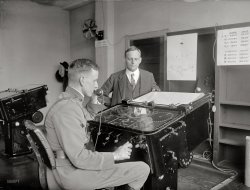
- Tires Slashed: 1922
- Washington, D.C., circa 1922. "Amalgamated Tires, 14th Street N.W." Hurry on down for our BIG SALE! ... at $250 per. I checked an inflation calculator and $10 in 1922 is about $125 today, and $20 is about $250. Seems the more things change, ... Posted by Dave - 08/07/2012 - 10:15pm -
![Tires Slashed: 1922 Washington, D.C., circa 1922. "Amalgamated Tires, 14th Street N.W." Hurry on down for our BIG SALE! National Photo Co. glass negative. View full size.
In the History of TiredomWhat a cruel irony that the truck carrying all those nice, comfy pneumatic tires is still rolling on solid-rubber tires.
Tire InflationI just bought new tires for my SUV at $250 per. I checked an inflation calculator and $10 in 1922 is about $125 today, and $20 is about $250. Seems the more things change, the more they stay the same.
How can you afford to slash your tires in half?"Easy. We're selling them at half price!"
6000 mile guarantee!The "firsts" have a 6000-mile guarantee. I wonder what the guarantee of the "seconds" and "thirds" might be.
Also, the best tire sign I've seen advertised a "huge tire blowout." I chose another shop.
Non-Skid TiresAs opposed to what -- Goodyear Slip-N-Skids?
Amalgamated? I always buy from Acme.
Stop! You're under arrest!... for savings!
Portage Cords and Fabrics
That fifth man ... is a reflection of the fellow holding the tire.
Another Center Door!And another center door Model T! Love the car pictures!
The 6,000-mile guaranteeWasn't as ludicrous as it appears today. People generally didn't drive that much back in the 1920s. From what I recall reading, the average was in the 2,000-3,000-mile range.
The fifth manMy favorite part of this photo is the fifth man, hiding (or so he thinks) behind the car on the left.
Absolutely, positivelynot there anymore. Across the street from Franklin Park, a footbeat of my youth.
Tire Inflation not the same.$250 today is a GREAT buy. Your new tyres today have a life 60,000 miles. The tyres from 98 years ago lived only a tenth of that. Better materials, better engineered, and much better ride quality.
Wow.Those two men in the middle remind me of my brothers Bill and John.
Super LOW Profile35-5's I bet!
Chains Next DoorI am curious about the pair of chains descending from the mailbox-looking protrusions on the building to the right of Amalgamated. Can't quite figure out their purpose.
[Seems to be a chain hoist, the kind used for window-washing platforms. - Dave]
Center Door SedanMy dad had a 1920 Ford center-door sedan. A fairly unique car. The driver entered through either door and had to go between the front seats to get into the driver's seat. The side windows were raised and lowered using a fabric strap. The gas tank was accessed by lifting the cushion of the driver's seat and removing the gas cap. You checked the gas supply by dipping a wooden stick about the size of a paint stirrer with graduated markings. To add gasoline, the hose was brought in through the driver's window or the passenger door. His car was painted up as a Black & White Taxi for the film "The Court Martial of Billy Mitchell," which was filmed in D.C. in 1955, starring Gary Cooper. The NON-SKID tires made by Firestone had those words as the tread pattern.
Re Center door sedanHiggins said: "The side windows were raised and lowered using a fabric strap." Chevy's ultra lightweight 1963 Grand Sport Corvettes (only five were built of a planned 125 intended for a factory racing program that was scuttled) had the same device to raise and lower their plexiglass side windows. The straps had a number of grommets which allowed the driver to position the windows at several openings with a hook on the door below the window opening. This arrangement of course saved a few very critical pounds by eliminating all the window winding hardware.
(The Gallery, Cars, Trucks, Buses, D.C., Natl Photo)](https://www.shorpy.com/files/images/30232u.thumbnail.jpg)
- Tasty Tom: 1922
- November 1922. Washington, D.C. "White House turkey 'Supreme 3' with unidentified ... unknowns.
The Baltimore Sun, December 3, 1922.
At the White House the turkey was received by Senator McKinley ... No mega-farms producing ghost white turkeys year round in 1922. The turkey and the lady in profile seem to have conspired to dress the ... Posted by Dave - 11/22/2012 - 9:55am -
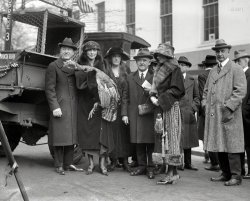
- Shutterbugs Ahoy: 1922
- "White House photographers, August 6, 1922." Possibly a recreational outing on the Potomac. National Photo Company ... I had no idea that the White House photographer pool in 1922 was staffed entirely by twelve-year-olds.
Swim Call
News ... Posted by Dave - 08/07/2012 - 12:42pm -
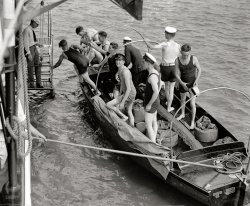
- Autocar Truck: 1922
- ... Johnson Gear & Mfg. Co., Berkeley, California, circa 1922.
(ShorpyBlog, Member Gallery) ... Posted by Mach52cm - 01/19/2023 - 9:24pm -
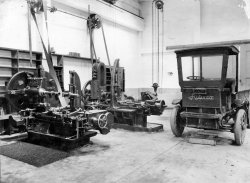
- Live It Up: 1922
- 1922. Washington, D.C. The actress Kay Laurell again, five years before her ... Posted by Dave - 07/25/2012 - 3:07pm -
![Live It Up: 1922 1922. Washington, D.C. The actress Kay Laurell again, five years before her premature curtain, with friends at the Potomac Tidal Basin. View full size.
Give me liberty...or give me....Another Broadway contribution to the war effort was the bust of Miss Kay Laurell. In the Ziegfeld Follies of 1917, a tableau by Ben Ali Hagan had Miss Laurell posed before crossed American and French flags in the fatigue uniform of a French soldier, blouse torn by some previously dispatched vicious German, exposing one reportedly magnificent breast. Word was that the French government ordered 200,000 copies of a photo of Miss Laurell's portrayal to use in an enlistment campaign. There is a suspicion that the word came from Ziegfeld's publicity people however.
On Kay"Any woman could get money out of a man. What took real skill was getting the money and evading the sleeping." -- Kay Laurell
"She was the most successful practitioner of her trade
of her generation in New York. She had all the arts of a first-rate harlot. The skull and crossbones were there on the label for all to see." -- Helen Hayes
And the URL is?So where's the shot of the reportedly magnificent breast? The February 1973 Playboy claims to feature Kay, among other Siegfeld [sic] Girls.
Oar Guitar GirlKay's friend on the right is the oar guitar girl from the canoe photo. Who was she?
Eleanor Griffith?Perhaps the other lass is Eleanor Griffith, Kay's costar in the production of "Ladies Night" then playing at the Belasco. The Library of Congress archives contain one labeled photo of Miss Griffith: I think the smile is very similar.
Update: another image of Eleanor, circa 1928:
Magnificently Breastless
This photo via the New York Public Library seems to be her famous costume from the 1918 Ziegfeld Follies. Some prude appears to have engineered a coverup. However those with a purely historic interest in Ms. Laurell's bosom may see it in several works by painter William Glackens, for whom Laurell repeatedly posed.
As You Are I Once WasDancing figures on the beach,
As the marks left by their feet,
Are all long gone.
And rising in far off in the mist,
We behold the obelisk.
The Cigaretteis nice touch on the beach.
My mother died in 1938 of pneumonia before antibiotics at the age of 36. A death like that now would be very unlikely.
Not exactly "Les Miz"As the war intensified, posing undressed began to be considered patriotic. If a woman stood naked posed as the Statue of Liberty, she was doing her duty for the American troops. Indeed, a record number of woman volunteered to be "undraped" in the 1917 edition's centerpiece. In the Ziegfeld Follies of 1918, which opened after the United States had joined the war, the curtain opened on a darkened stage to reveal a huge revolving globe with Kay Laurell perched on top, breast exposed. Little French girls in rags, a dying soldier attended by Red Cross volunteers, and a trench over which doughboys charged amid devastating gunfire completed the scene. Gazing down on a Ben Ali Haggin set piece designed to look like the world burning, Laurell was supposed to represent the spirit of France.
-- From "Striptease: The Untold History of the Girlie Show" by Rachel Schteir.
A Photo Shoot...Is no reason to interrupt one's smoking.
The Genuine ArticlesI don't know if they are "magnificent," but like they said on Seinfeld: "they're real, and they're spectacular!"
The Ziegfeld TableauThe tableau described by gblawson is fairly standard French imagery; a depiction of Marianne (the symbol of France) fighting and victorious. This version of Marianne is inevitably depicted wearing a Phrygian cap (in Roman times indicating a freed slave) and one breast bared, recalling the goddess Athena. Probably the most famous depiction is Delacroix's 1830 painting "Liberty Leading the People."
How it might have looked in colorCouldn't resist. Click to enlarge.
Kay LaurellKay Laurell did not die from pneumonia. She died in childbirth.
Wikepedia is not correct. She had a son, don't know what happened to him, he was to inherit her estate. Read the newspaper article.
re: Kay LaurellIMDB and Wikipedia both claim pneumonia as cause of death since that is what was reported in the New York Times obituary. A story in a 1930 edition of the Miami News does however reinforce the contention that it was death by childbirth.
(The Gallery, D.C., Natl Photo, Swimming)](https://www.shorpy.com/files/images/06832u.thumbnail.jpg)
- Loud and Clear : 1922
- ... radio. Photograph by Underwood & Underwood, April 18, 1922. View full size. (Updated with additional information on Lester — ... From the Brownsville (Texas) Daily Herald of April 25, 1922:
The Decatur (Illinois) Sunday Review of April 16, 1922:
... Posted by Ken - 09/08/2011 - 8:47pm -
![Loud and Clear : 1922 Lester Picker listens to his shortwave radio through earphones while convalescing after breaking his back when he fell 55 feet erecting an aerial for the radio. Photograph by Underwood & Underwood, April 18, 1922. View full size. (Updated with additional information on Lester — click here and scroll down.)
At least……he finished the job, didn't he?
Finished The Job......One might think so.
Ah, the things that we radio buffs go through to get a signal in [or out].
Lester's radioLester's rig looks like a single band receiver, probably the AM broadcast band. The receiver designs back then were very simple and touchy to tune. The most common three dial receiver design used three tubes to amplify the signal, the design today is called a TRF receiver. The dials didn't have kHz marks, just 0-100 logging marks. There was also a gain control that had to be constantly adjusted as the signal faded or strengthened. I used to have a very similar antique receiver, called a 'Freshman Masterpiece'. It had five tubes, three for amplifying the radio signal and two for amplifying the audio... and they were all the same type, O1-A triodes. Pentodes and tetrodes were still on the horizon.
If you look on top of the receiver, you can see an array of batteries, since that was the common power source back then. There would be a -22 volt grid bias battery, a 6.3 volt lead-acid battery for the filaments (usually recharged from a windmill generator) and a +90 volt plate battery.
I think his Diploma of Graduation was either from a radio school or it could have been a high school.
Is he a ham?wondering if that diploma on the wall is a Federal Radio Commission ham license? or one of the many "radio school" diplomas around back then? Does anyone have a Radio Amateur's Callbook from that era to look for the name?
Lester Picker, 6AJH and 6ZHLester was a licensed shortwave (or "ham") radio operator who achieved national fame after his fall. From the Brownsville (Texas) Daily Herald of April 25, 1922:
The Decatur (Illinois) Sunday Review of April 16, 1922:
From the Oakland Tribune of March 11, 1923:
FAN BREAKS BACK BUT GRADUATES BY AID OF RADIO
San Ysidro Youth Addresses Class by Air; Whole Coast Is Friend
(By a Listener-In)
SAN YSIDRO, Calif., March 10 — There is not an amateur up and down the Pacific Coast who will not cut in and answer when he hears amateur radio station 6ZH calling.
These call letters, meaningless to so many radio fans, have a deeper significance in the hearts of dot-and-dash amateurs. They know that 6ZH is the only one among them who has the right to be lonely. “How are things tonight?” they say. Sometimes they pause for a lengthy chat. Their reward, though unseen, is a smile lighting up the face on a pillow thousands of miles away.
At the word of greeting a hand will reach to the bedside and fondle an old brass key. There is a splutter, the tubes light up, and singing back through the ether comes 6ZH’s answer: “Fine, Old Man. How are you?”
Down on his luck, but what of that? — 6ZH Lester Picker, District Superintendent of the American Radio Relay League, has brought the whole world to his bedside and you will find him there in the evening with his chin up, talking to his pals of the A.R.R.L. along the coast.
He knows most of them, the amateurs, from Vancouver to the Gulf and now and then he will seek out an old friend to the banks of the Mississippi. There is fun in distance when you measure your own movements by inches. If there is anyone who can get action out of his [illegible], Picker and his signal is like the crack of the whip.
There is much to take into account, of course, if it were not for amateur radio in the first place. Picker would not be lying there with that ache in his back, but still, if it were not for radio, life would be lonely.
And, yes, here is another thing, too: it was amateur radio that enabled Picker to be graduated with the rest of his class at the Roosevelt Memorial High School in San Diego. The accident happened only a short time before the exercises and he was due to receive his diploma with the rest.
A rather difficult situation, you might think, for a chap whose back was broken, yet the seemingly impossible was accomplished and not only is the diploma hanging on the wall, where 6ZH can glance at it proudly, but he also gave an address from the platform of the auditorium. The chair where Picker was to sit with his classmates was vacant, but who will say he was not there? At a word from Principal T. A. Russell, someone telephoned a San Diego amateur, who relayed the message by radio to 6ZH; a switch was thrown in and a hush fell over the auditorium, while the eyes of those present turned toward a big horn on the stage.
“Picker,” thought his classmates, and listened carefully. In the next few minutes, there was no other sound except Picker’s voice, not until he signed off, at least, with his customary “Goodnight, Station 6ZH.”
Even on this eventful night, he clung to his old familiar call, and in the interval, he told of the pleasure which it gave him to be graduated with the others in his class and expressed the hope that he might join sometime his mates of ’23 and talk over experiences.
And now you must wonder why Picker did not fill the chair on the platform that night. One day he was installing a new 55-foot mast at his new station and the guy wires broke. “Radio again,” you say.
But now you know why the amateur radio “ops” listen when he calls.
And finally, from the "A.R.R.L. Events" column of the Woodland (Calif.) Daily Democrat, March 18, 1925:
Lester Picker, 6ZH, has received his O. W. L. S. appointment and has already begun to sign his wavelength after communications.
LesterExcellent info, Dave. Thanks for clearing up all the mystery.
73 de Ham Radio Curmudgeon
(sorry, I learned long ago to not use my call letters on the net.)
Not a HamThe certificate on the back wall appears to be a Diploma of something (probably Graduation but the cable obscures a couple of letters) so that's no proof of whether he's a Ham operator. What we're looking at appears to be an old three dialer with headphones for listening rather than a speaker horn - probably due to the rather primitive state of amplification in those days.
[Not so. See above. - Dave]
Callsigns?So if I've got this right, 6ZH was a subsequent call sign he probably earned after upgrading his license from the earlier 6AJH? The callsign format is way before my time, and I've been licensed for close to 30 years....
What license classes were each of these?
73's
Sid
LesterHere's a QSL he sent in 1925... Some notes on his antenna on there too!
http://hamgallery.com/qsl/country/USA/California/6zh.htm
Morse code keyOn the large photo you can clearly see a telegraph key on top of the receiver. These were used to send morse code transmissions and those wires hanging down connect to this key and I suspect go to a transmitter in another room since transmitters in those days were quite bulky and would be too big to fit on the table.
Lester PickerI'm so happy to have stumbled onto this page! Lester Picker was my grandfather's first cousin. He was born December 26, 1905 in San Francisco and died in Los Angeles on May 10, 1930 from complications due to his infirmity.
His younger sister, Sylvia Picker (1909-1981), was an actress, mostly on radio. The family moved from New York to Southern California because Lester's father Herman had tuberculosis, and needed the dry climate. He died anyway in 1924 at age 44.
After Lester died, he was returned to San Diego for burial next to his father.
Sylvia Picker McGrawSylvia was my step-grandmother. We loved her dearly and miss her. She married my father's father Stokely McGraw. My dad was Roland George McGraw, who lives in the Palm Springs
area.
Kelly
KMcGraw48@hotmail.com
(Technology, The Gallery, Curiosities)](https://www.shorpy.com/files/images/3c34576u.thumbnail.jpg)
- Bathing Girls: 1922
- "Lansburgh Bathing Girls, 1922." Avert your eyes, gentlemen -- the leftmost lady's knees are showing. ... Posted by Dave - 07/06/2018 - 10:18pm -
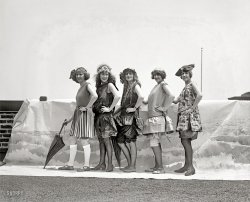
- Off the Rails: 1922
- July 31, 1922. Laurel, Maryland. "Two B&O freights wrecked in head-on crash at ...
CREWS ESCAPE BY JUMPING Washington Post, August 1, 1922.
2 FREIGHTS CRASH
AT LAUREL SWITCH
Both Engines and 4 ... Posted by Dave - 02/06/2014 - 2:28pm -
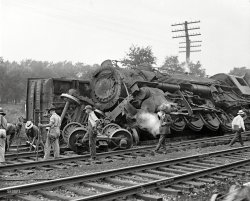
- Print Shop: 1922
- January 1922. Washington, D.C. "Machinists' Association -- printers." Activities ... but my mind still has difficulty processing the fact that 1922 was already 100 years ago.
Grand Lodge, International Association of ... Posted by Dave - 12/29/2021 - 4:51pm -
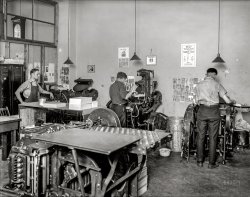
- Assimilates the Food: 1922
- October 21, 1922. Washington, D.C. "Shriners barbecue." And a promotion for Prohibition-era ... photograph from this picnic is seen at Blazing Saddles: 1922 .
Washington Post, Nov 2, 1924
The Noyes mansion, ... Posted by Dave - 10/20/2020 - 2:41pm -
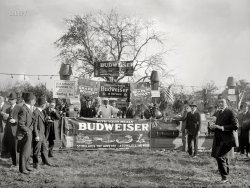
- Woman's Bureau: 1922
- November 1922. Washington, D.C. "Woman's Bureau, Metropolitan Police Dep't. Telephone ... Posted by Dave - 09/13/2011 - 11:17pm -
![Woman's Bureau: 1922 November 1922. Washington, D.C. "Woman's Bureau, Metropolitan Police Dep't. Telephone calls bring prompt attention." National Photo Co. View full size.
Cold OfficeI just noticed that she is on the exterior side of that double hung window. That really makes this office uninviting!
Behind BarCan't decide if that bar is to keep her in or others out. In either case, it appears one would have to crawl under it. At least she has the keys.
Hey! Fish!If this was NY's 12th Precinct, I would expect Wojo and Fish were out on a call. Obviously they modeled the set of "Barney Miller" on this.
ErgonomicsThat particular arrangement is my personal idea of hell.
So spatious and invitingNo expense was spared to accommodate the WB.
[It was an extra-spatial kind of spatiousness. - Dave]
Nothin' like a hairnetTo take away any semblance of sex appeal.
Call indicator boxI have an oak call box in my kitchen the same as the one to the right of the light fixture; it was once used to summon the servants to different rooms by pushing doorbell buttons. The DC police must have used this one as an intercom of some kind.
Washington "And Nearby Places"What a quaint expression, that!
Not a negative commentDingy, and a lot of it doesn't seem the fault of an old negative.
Cell, PhoneIf this is typical of an office in the DC Police Department, I'd hate to see what the cells in the DC Jail looked like.
One Ringy Dingy, Two Ringy DingyIs this the party to whom I am speaking?
911 What's your emergency?We'll have a car out there sometime this week.
Hello CentralGive me Dr. Jazz.
Ruth Buzzi the elderly Lily Tomlin?The large purse is absent!
Giant fingerprint faux finishMaybe Martha Stewart will have a special on how to achieve that in your own police station.
Also, funny how this photo makes even the pencil sharpener look old-fashioned, even though hand-cranked ones are still fairly common.
Everything within easy reach... except the pencil sharpener! That chair will swivel so she can easily use the books on the other table, and the typewriter is well out of the way of the writing surfaces. I've worked in worse.
Security Fire AlarmI love the little iron hammer on the short chain. Break the glass to get to the fire alarm button. If a prankster sounds the alarm, just follow the blood trail. If the fire is real, well, decisions, decisions.
Nearby PlacesGreetings from Bethesda, Maryland, one of those "nearby places." Which unfortunately can now take an hour or more to drive to during rush hour from downtown D.C.
Guess it's not as nearby as it used to be!
The dark side of the BureauMs. Mina Van Winkle, director of the D.C. Police Women's Bureau, provided this explanation to an audience in Boston in 1920: The Bureau was organized to enforce "the District's war-time legislation," but "proved so valuable as an emergency measure that it has been made permanent." In 1928 Ms. Van Winkle told a reporter that "Washington is the mecca for all psychopathic women of the nation."
The feature story explained that one of the Bureau's functions was protecting lawmakers "from psychopathic women who flock to the city while Congress is in session with wild and utterly unfounded tales of wrongs done them by prominent men. ... Due to the vigilance of the policewomen, the government officials and other well-known Washingtonians accused of serious misdemeanors often do not even know they have been involved," because the Bureau's policewomen intercept such women, sending some to "some insane asylum" and others home to their husbands, fathers, or brothers.
Depressing dimensionsWhen your office is taller than it is wide, that's not good.
Fish on bun, Jello and milkShe must not have been paid much. From the looks of that sassy hairnet, she had to moonlight as a cafeteria lady.
What, no spittoon?Not fair.
Immaculate PerceptionOf course, this young lady's hairnet was quite common in those days. The cleansers and hair treatments of the day were unsophisticated, which made hairstyling a challenge. Mass production made the fine mesh solution to runaway or frizzy hair available to all women, at a cost most could afford. The hairnets were sold at accessory stores in individual boxes and put out on display, along with the fine gloves and stockings. A great many women, from Bonnie Parker to Eleanor Roosevelt, wore hairnets when they were considered a neat, clean, and feminine beauty product.
(The Gallery, D.C., Natl Photo, The Office)](https://www.shorpy.com/files/images/23672u.thumbnail.jpg)
- Snow Bird: 1922
- February 1922. "Woman on sled being pulled by biplane in snow, with Washington Monument ... the bathing suit! It is fortunate, however, that it was 1922 and not 50+ years later!
Jenny That's a Jenny (JN4D).
It's ... The caption accompanying the photo in the February 4, 1922, Washington Post.
“Whee-e-e-e! If you want a real thrill try ... Posted by Dave - 02/13/2014 - 1:46pm -
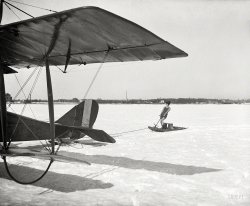
- Super Six: 1922
- Washington, D.C., circa 1922. "Hudson Coach, Connecticut Avenue Northwest." National Photo Company ... that this car is not a Hupmobile at all. It is actually a 1922 Hudson Super 6 Coach. This body style was a two door, 5 passenger which ... for $1,795. Due to its immediate popularity, by the end of 1922 they were able to lower the price to $1625. Hudson pioneered this body ... Posted by Dave - 09/13/2011 - 7:24pm -
![Super Six: 1922 Washington, D.C., circa 1922. "Hudson Coach, Connecticut Avenue Northwest." National Photo Company Collection glass negative. View full size.
FormalwearFor some reason, autos in this style remind me of a dapper young man in tuxedo, tails, and a top hat!
WhitewallsAre those Fisk Cords you're sporting?
Urban LegendThe periodic rumour that the car on the old-style US {$10} bill was a Hupmobile has been strongly denied by the US Mint and the Bureau of Engraving. The original engraver used a composite of many US cars so as not to favour any one manufacturer.
[This information comes from the internet so it may or may not be true]
NearbyYou can see St. Matthew's Cathedral in the background over on Rhode Island Avenue. Dupont Circle is to the left and Farragut Square is down Connecticut Avenue to the right. The car is not on Connecticut proper but just off. I used to work at 1225 Connecticut, which is just about 200 feet away. I think Jack Pry[e] had a car sales showroom right across the street from this shot, back in the 50s. Some of the buildings across the Avenue are still there, including the building with the bay windows. A great section of Connecticut Avenue.
ShineThe paint finish & gloss on that car is amazing, even by today's standards.
Hupmobile TriviaAn image of the Hupmobile is featured on the back of the old US $10 bill.
No longer usedThat's lacquer for you. Looks stunning when it's new.
It's a Super 6 !!If you zoom in on the hubcaps, you will see that this car is not a Hupmobile at all. It is actually a 1922 Hudson Super 6 Coach. This body style was a two door, 5 passenger which sold new for $1,795. Due to its immediate popularity, by the end of 1922 they were able to lower the price to $1625. Hudson pioneered this body style as the first closed car available on the market in the same price level as an open touring car. By comparison, a Hudson Super 6, 7 Passenger Phaeton (an open touring car) sold for $1745. Hudson Motor Car Co. was the world's largest manufacturer of six cylinder automobiles at this time.
Darn the luckI threw away all my old $10 bills when the new ones came out, so I guess we'll never know.
Famous Super Six ChassisPart of a sign is reflected in the rear window. Essex and Hudson advertised a 'Coach on the Famous Super Six Chassis' from what I could find in Google.
Perhaps this scene was a street-side auto show of sorts?
Today's Shorpy PuzzlerWhy does a Hupmobile have hubcaps that say Hudson Motor Car Co.?
[The hubcaps say Hudson Super Six. Because, as you and other sharp-eyed Shorpians have ascertained, this is a Hudson. (I had meant to publish a different photo -- Hupmobile fans will have to wait a few more days.) - Dave]
You could eat off those running boards!The car's finish is incredible. Look at the other cars in the distance, chalky and dull. Schmedleymobiles and Putzmobiles they are. Not the noble Hupmobile.
re: ShineThe paint finish & gloss on that car is amazing...
You started me looking at the reflection. I upped the contrast and stretched it to better see the photographer, his tripod and two companions.
(The Gallery, Cars, Trucks, Buses, D.C., Natl Photo)](https://www.shorpy.com/files/images/30237u.thumbnail.jpg)
- Style Show: 1922
- June 17, 1922. Washington, D.C. "Group winners at Tidal Basin bathing beach." On the ... Posted by Dave - 01/07/2022 - 4:58pm -
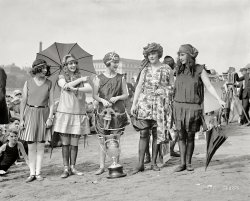
- Washington Sleeps Here: 1922
- Washington, D.C., circa 1922. "New Jersey Avenue S.E. from B Street." Lodgings in this view from the ... taking only one spot was not all that important even in 1922.
Hotel Potomac The Hotel Potomac across the street retains at ... Something's Wrong It's actually several years past 1922.
The District of Columbia license plates seen on the cars indicate ... Posted by Dave - 05/14/2014 - 12:01pm -
![Washington Sleeps Here: 1922 Washington, D.C., circa 1922. "New Jersey Avenue S.E. from B Street." Lodgings in this view from the House Office Building include the Potomac, Congress Hall and President hotels (sign at left), as well as the George Washington Inn. National Photo Company Collection glass negative. View full size.
Always One in Every CrowdAll the cars parked left to right except one. That owner backed in.
Even Then --Looking at the car parked at the end on the bottom right, I see that pulling in straight and taking only one spot was not all that important even in 1922.
Hotel PotomacThe Hotel Potomac across the street retains at least some of the structure, and sits on the same site, of the old Conrad and McMunn boardinghouse, where Thomas Jefferson lived while he was vice president. Alas, that whole block would be razed in 1929.
What a beautiful sidewalkThat would be the envy of any city today.
There it isWhat would a Shorpy photo be like if there were no milk bottles on the window sill?
Interesting vehicleAnyone know what kind of car the 3rd car from the right is? Unusual as it has no front radiator.
[It's a circa 1916 Franklin, which used an air-cooled engine. - Dave]
Car ID's suggestionsFront row R to L: Studebaker; Star; Franklin; Velie; unknown; Ford; Studebaker; Studebaker; Haynes; Ford; Dodge(dirty); Pierce-Arrow; Studebaker; Buick; 2 Ford coupes; hidden car; Ford sedan etc. Back row two cars in front of bus and three directly in back are all Fords including one converted to a truck. Car with plate 10845 with knife edge styling is a Hudson. Others need more study.
The House SideThe hotels are on the present site of the Longworth House Office Building. The Cannon Building, from which the photo was taken, was built about 1908. B Street is now Independence Avenue; the photo looks toward C Street SE. South Capitol Street, which divides the quadrants, is a block west (right) between Longworth and the Rayburn Building, which was built in the early 1960s.
Something's WrongIt's actually several years past 1922.
The District of Columbia license plates seen on the cars indicate that this photo was actually taken in 1925. The format of the 1925 D.C. plate, with "Dist. Col. 1925" between the bolt slots is a one year only feature.
Confirming the date is the presence of a late 1924 or 1925 model Pierce Arrow Model 80 (12th car from the right).
Other cars at the beginning of the row:
1920-1921 Studebaker Big 6 (Model EG)
1922 Star (made by Durant Motors)
1914 - 1916 Franklin Series 8 (note electric lights)
1925 Cleveland Six Model 43
1920 - 1922 Oldsmobile Model 46
Ford Model T
Note how few cars have front wheel brakes.
(The Gallery, Cars, Trucks, Buses, D.C., Natl Photo)](https://www.shorpy.com/files/images/SHORPY-31742u1.thumbnail.jpg)
- Rainey's Harley: 1922
- At the White House gates. "M.A. Rainey, October 5, 1922." National Photo Company Collection glass negative. View full size.
... O.E. Morgan.
Washington Post, Feb 28, 1922
Wrecked in Liquor Race
An exciting chase between Park ... Posted by Dave - 04/06/2013 - 11:48am -
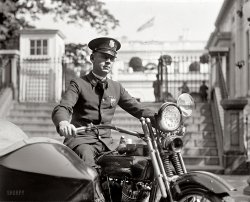
- Frosty the Mailman: 1922
- ... completion of their appointed rounds.
January 1922. Washington, D.C. "Snow scenes after blizzard." When the mailbox is also ... of '22
Washington Post, January 29, 1922.
Blizzard Costs 1 Life;
Capital Goes Afoot;
Business is ... Posted by Dave - 02/16/2014 - 10:32am -
![Frosty the Mailman: 1922 Neither snow nor rain nor heat nor gloom of night stays these couriers from the swift completion of their appointed rounds.
January 1922. Washington, D.C. "Snow scenes after blizzard." When the mailbox is also an icebox. Harris & Ewing Collection glass negative. View full size.
UniformAs an ex letter carrier I wonder if that was the standard winter uniform at the time.
Also what the "D" meant on his hat? I don't think he was a carrier as they would have had to take the train or bus to get to their routes, they would not have been collecting bags of mail.
Blizzard of '22
Washington Post, January 29, 1922.
Blizzard Costs 1 Life;
Capital Goes Afoot;
Business is Halted
More than 24 inches of continuous snow had last night covered the middle Atlantic section, with Washington as a center, to a depth of a foot to nearly 30 inches; caused the suspension of practically all business and social activity; disrupted transportation and shut most of the populations in their homes.
The storm, which weather bureau officials, after looking up their records, said was one of the most severe in history and exceeded in the depth of snowfall only by the long-remembered blizzard, 1899, was moving slowly last night up the coast from its position during the day off Virginia. …
Automobiles and other motor vehicles likewise were unable to cope at all during the day with the snow and last night the streets of downtown Washington were lined with abandoned cars, some of which owners had not been able to move since Friday night. Taxicabs did a thriving business, but as the snow increased their numbers were decimated by the drifts. …
Thousands of government employes walked to work and many in the outlying or suburban sections stayed at home. When noon came and the storm showed no signs of abating and the weather bureau held out no hope, many bureaus dismissed the employes so as to allow them to get to their homes.…
Mailman or doorman?With the "D" on his cap, I'm wondering if this might be a doorman or porter from a hotel or building, putting mail into the box.
[Only a postal employee would have access to the interior of the box. Also, his badge is an official Post Office Department issue - the last year of this wreath design, in fact. I haven't been able to find the significance of the "D"; usually it's a number, but others denote a specific function. -tterrace]
"D" on Postal Uniform CapMaybe the D stands for Delivery, as that is what he appears to be doing: getting ready to deliver mail.
[Badges for letter carriers (aka"mailmen") were numbered. At any rate, he's not delivering, he's collecting mail - in this case packages - customers have deposited in the box. -tterrace]
"D" for "Driver"?In an age when autos/trucks were still relatively new and not everyone had a drivers license, maybe he was a driver. Possibly driving a truck to pick up mail from the boxes around town.
RelaysBack then they may have had relay boxes. You would case your mail for the route, put it in a bag and it would be dropped off in a green relay box.
You would then go to that box, take out the mail for your route and then deliver it.
Maybe back then they used regular mail boxes for relays.
(The Gallery, D.C., Harris + Ewing)](https://www.shorpy.com/files/images/SHORPY_41931a.thumbnail.jpg)
- Left and Right: 1922
- Washington, D.C., 1922. "Auto accident." View full size. National Photo Co.
Acronyms ... this car had Maryland and DC license plates, both from 1922. Does it mean it was possible to register your car in two states back ... Posted by Dave - 06/09/2018 - 5:17pm -
![Left and Right: 1922 Washington, D.C., 1922. "Auto accident." View full size. National Photo Co.
AcronymsWow, the original "Found On Road Dead" Ford!
Whooee.Transverse leaf spring front suspension! Talk about ancient.
Wheel Alignmentand here we see excess toe out and negative camber
Another Fine MessThis real-life shot reminds me of several Laurel and Hardy short comedies in which Tin Lizzies met similar fates. This poor "T" has an almost human helplessness in this photo.
Amen!You're right, Anonymous Tipster! It doesn't take a lot of imagination to see a dejected human in this car...this looks like me after Summer School registration today!
An Accident?Was it really an accident? (I love the understatement of that title/description, by the way.) Somehow, it looks as though the car simply gave up, albeit in a less spectacular fashion, in the same way that the Dodge Monaco gave up at the end of the Blues Brothers movie.
"Our lady of blessed acceleration, don't fail me now!"
[As we can see, it drove halfway up onto the streetcar platform. - Dave]
Why the two license platesfor both Maryland and the District of Columbia?
[Because you had to have a plate for each jurisdiction the car was driven in. - Dave]
Double registration?I just noticed, this car had Maryland and DC license plates, both from 1922. Does it mean it was possible to register your car in two states back then?
(The Gallery, Bizarre, Cars, Trucks, Buses, D.C., Natl Photo, Streetcars)](https://www.shorpy.com/files/images/06506u.thumbnail.jpg)























